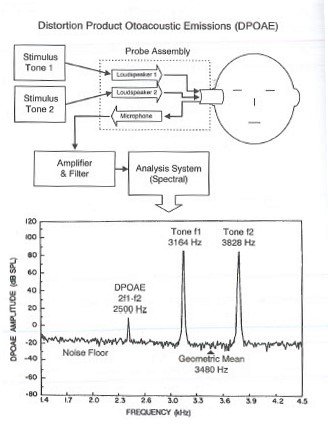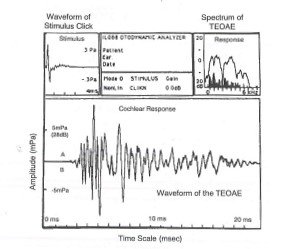OAE
Otoacoustic Emissions (OAE) are low-level sounds generated by the outer hair cells (OHC) of the cochlea in response to an auditory stimulus. First theorized by Astrophysicist Thomas Gold in the mid 1950’s and experimentally confirmed by David Kemp in 1978, OAEs are an essential tool in Newborn Hearing Screening programs and the differential diagnosis of cochlear pathology. Let us review the different types of OAEs and factors that will influence these measurements.
OAE Factors
The ear canal is a key variable when obtaining OAEs. The stimulus is delivered, and the response is measured in the ear canal. It is essential that the canal is free of obstruction and the probe tip can seal sufficiently at the canal opening. The status of the middle ear system is another important factor in obtaining accurate and repeatable results. It is crucial that it is functioning normally with middle ear pressure close to atmospheric pressure for the stimulus to pass through and for the emission to travel out where it can be measured in the canal. The cochlea is the most important factor in OAE measurement. Present OAEs require intact and normal functioning outer hair cells to complete the complex sequence of events in order to measure the resulting emission in the ear canal. Finally, noise needs to be minimized to record an OAE measurement. We are trying to measure very soft emissions, and noise that is generated from the environment or due to movement can mask the OAE we are trying to measure. It is crucial to manage the environment and patient to assure you are obtaining accurate and repeatable results.
SPONTANEOUS OAE
Spontaneous Otoacoustic Emissions (SOAE) are emissions that can be measured in the ear without using stimulus. It is estimated that they can be detected in just under 50% of the population, but currently there is not any clinical utility to measuring them.
DPOAE
Distortion Product Otoacoustic Emissions (DPOAE) are acoustic signals that can be detected in the ear canal of a person with normal outer hair cell function, after stimulation of the auditory system with a pair of pure tones at frequencies f1 and f2. The frequency pairs are presented at a f2/f1 ratio of 1.22. The resulting emission of interest is the distortion product tone at the frequency 2f1-f2. The instrument generates a series of test tones, directs them into the ear canal, and then measures the level of the DPOAE tone generated by the cochlea. By using different test frequencies, the device provides an estimate of outer hair cell function over a wide range of frequencies.
Follow the link to learn more about Otoacoustic Emissions.

Gelfand, Stanley. Essentials of Audiology. New York, Thieme Medical Publishers, 1997.
TEOAE
Transient Evoked Otoacoustic Emissions (TEOAE) are acoustic signals that can be detected in the ear canal of a person with normal outer hair cell function, after stimulation of the auditory system with a series of wideband clicks. The instrument generates a series of clicks, directs them into the ear canal, and then analyzes the spectrum of the returning signal, separating the noise and emission. By using band pass filters, the device provides an estimate of outer hair cell function over a wide range of frequencies.

Gelfand, Stanley. Essentials of Audiology. New York, Thieme Medical Publishers, 1997.
WHAT DO OTOACOUSTIC EMISSIONS RESULTS TELL US?
The presence of otoacoustic emissions suggests normal outer hair cell function. This, in turn, correlates to normal hearing. However, a passing result is not an indication that the full auditory system is normal. A result indicating present and normal otoacoustic emissions should not be allowed to override other indications that hearing loss may be present. A full audiologic evaluation should be administered if concerns about hearing sensitivity persist. In addition, an absence of OAE’s should not be assumed to be an indicator of a lack of auditory function or the presence of pathology. However, it should be followed with full audiologic diagnostic testing and/or medical evaluation as appropriate.